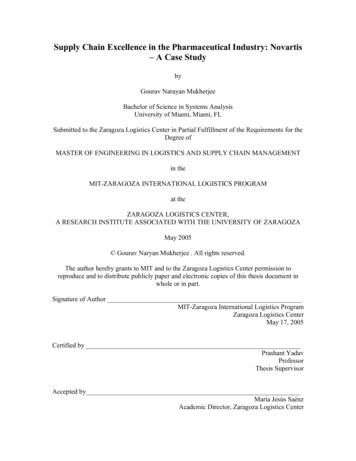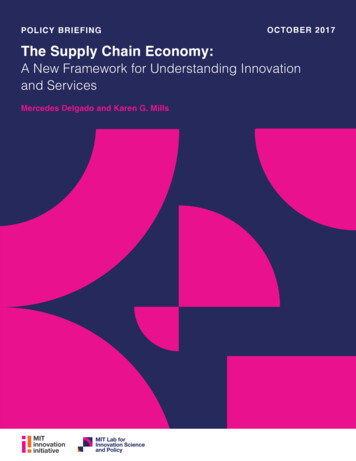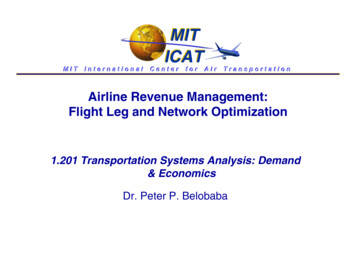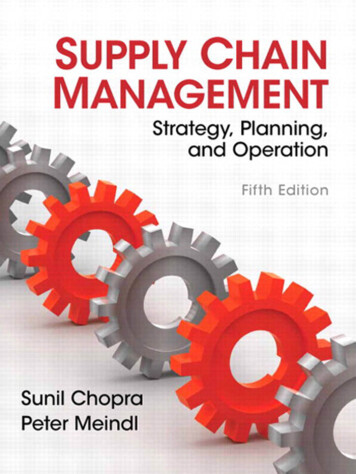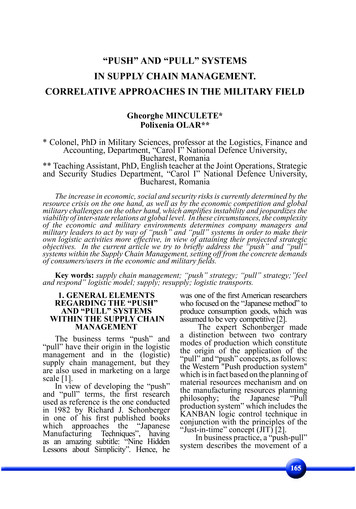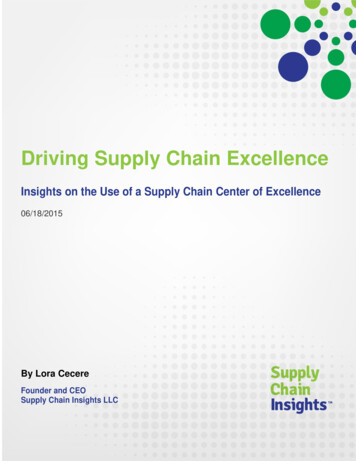
Transcription
Driving Supply Chain ExcellenceInsights on the Use of a Supply Chain Center of Excellence06/18/2015By Lora CecereFounder and CEOSupply Chain Insights LLC
ContentsResearch Methodology3Disclosure3Executive Overview5A Clear Supply Chain Strategy Means Greater Success7What Is the Value Proposition for a Center of Excellence?8What Does a Center of Excellence Do Well?11Current State12Organizational Design, Structure and Governance14Evolution of Supply Chain Design: A Maturity Model16Recommendations20Summary20Other Relevant Reports21Appendix22About Supply Chain Insights, LLC30About Lora Cecere30Page 2
Research MethodologyThis report shares the results of a quantitative survey on supply chain Centers of Excellence (COE)along with insights gathered through roundtable discussions. In Figure 1 we share the objectives,methodology, and demographics of the study.Figure 1. Survey OverviewDisclosureYour trust is important to us. In our business, we are open and transparent about our financialrelationships and our research operations. To develop this research we partnered with Chainalyticsto drive a response rate. Throughout this research process we maintain anonymity of therespondents. It is our policy to validate the research participants, but to never share the names ofrespondents or give attribution to the open comments collected in the research study.This report is written and shared using the principles of Open Content research. It is intended for youto read and share freely with your colleagues and through social channels like LinkedIn, Facebookand Twitter. When you use the report, all we ask for in return is attribution. We publish under thePage 3
Creative Commons License Attribution-Noncommercial-Share Alike 3.0 United States and you willfind our citation policy here.In the development of research, our philosophy is “You give to us, and we give to you.” We empowerthe spirit of the crowd. Participants in our research always receive the final reports; and, if interested,we will share our insights with the respondents of our quantitative surveys and qualitative interviewsin a one-hour phone call with their team. Participants in this research also had an option to participatein a networking roundtable. Forty-one supply chain leaders participated in these roundtables. Whereappropriate we share their feedback on the quantitative study.We remain committed to delivering thought-leading content for the supply chain leader. It is our goalfor Supply Chain Insights to be the place where visionaries turn to gain an understanding of the futureof supply chain management.Page 4
Executive OverviewGrowth is slowing and the complexity in today’s supply chain is unprecedented. No two centers ofexcellence are the same, and no two supply chains are alike. There are different drivers andobstacles to building and running a Center of Excellence. However, if done right, the organizationrates itself as more aligned, proactive and agile. The high-level results from our study are shown inFigure 2.Figure 2. Centers of Excellence InfographicPage 5
Based on our qualitative interviews with clients, we find that these seven drivers to build a Center ofExcellence: Increase in the Importance of Supply Chain Management. As growth slows, and the globalmultinational organization matures, more and more companies are interested in driving supplychain excellence. The reasons are many; but, at the top of the list is improving reliability in the faceof volatility. How so? Demand volatility is increasing and supplier viability is growing more fragile.Driving reliability in global operations in the face of these challenges is fundamental to defining andexecuting supply chain excellence. Building of Global Teams and the Development of Supply Chain Talent. With the shortage ofstudents from academia, and the retirement of the first- and second-generation supply chainpioneers, more and more companies are developing and executing programs to build supply chaintalent. There is a shortage of mid-management talent with pressure on planning job retention. Thereis a limited supply of supply chain knowledge workers: leaders that are technologically savvy,analytical problem solvers, and astute in business processes. Continuation of Work on Enterprise Resource Planning (ERP). When companies complete alarge ERP project, there is a strong impetus to get the value from the investment and ensuretechnology usage. The focus of the Center of Excellence often becomes an extension of the globalimplementation team. Metrics and Implementation of Analytics. While the management of supply chain excellencesounds easy, it is not. The management of order-to-cash and procure-to-pay processes and thesupply chain execution processes are easier because they are well-defined. Most companiesstruggle with the definition of planning and the use of new forms of analytics. Network Design and the Orchestration of Flows. Most companies start on their supply chaindesign journey to save costs in logistics. With the increasing cost of transportation, and the fragilityof freight networks, network design for transportation and logistics networks is paramount. Oneclient likened it to “minting money.” Testing of New Technologies. Cloud technologies. Supply chain operating networks. The Internetof Things. 3D Printing. New forms of analytics. The list of technology and process disruptors couldgo on and on. While most companies feel stuck in their existing, and more traditional, processesthey want to understand and explore technology possibilities to define a digital supply chaintransformation road map. The supply chain Center of Excellence is a natural starting point. Mergers and Acquisitions. Mergers and acquisitions drive change for the supply chain requiringthe design and orchestration of the value network to gain synergy. With heightened politics, and theneed to rationalize the processes in the time of M&A, the supply chain Center of Excellence isessential to rationalize process definition and technology adoption.Page 6
One out of two companies surveyed for this study reported having a supply chain Center ofExcellence; but, only one in two believe they are successful. Despite the strong and compellingdrivers, success can only happen when there is a supportive culture. The goal of this report is to helpsupply chain leaders beat the odds.A Clear Supply Chain Strategy MeansGreater SuccessWhile it is easy to define “What Good Looks Like” for transactional systems, defining the End-to-Endvision for the Supply Chain Value Network is more difficult. The typical steps for the End-to-EndJourney are outlined in Figure 3.Figure 3. Journey for End-To-End Supply Chain ProcessesThese steps are more nebulous than the definition of transactional systems, requiring a cleardefinition of the supply chain strategy as it ties to the business strategy. When successful, there is aclear definition of the goals: well-defined process orchestration with new product launch,processes/product platform rationalization, and clarity of business policies in supplier/commercialrelationships.As new forms of analytics evolve, new capabilities are being defined in the Center of Excellence andthe processes of supply chain planning, inventory management, and network design are evolving. Forthe successful Center of Excellence this is at the heart of the mission.In Figure 4, for the purposes of this report, we define supply chain strategy. In the areas of planningPage 7
and network design the questions in the green and white boxes must be answered before companiestackle the definition of business process. When this is completed, there is clarity of outcomes and theoptimizers within the technologies can be tuned to manage conscious trade-offs. However, if thisdoes not happen, the tools and technologies work at cross-purposes: optimizing different things withvaried outcomes.Figure 4. Definition of the Supply Chain StrategyWhat Is the Value Proposition for a Center ofExcellence?The differences in organizational alignment are marked based on the inclusion of a network designgroup within the center of excellence. Maturity in network design improves alignment. In companiesgreater than 10 billion in revenue, three out of four Centers of Excellence includes a group focusedon network design. They average two, not one, and the centers are four-years old on average. Twofifths of companies have both a Center of Excellence and a Network Design group. They are closelycoupled and work together to drive alignment improvements.A ‘supply chain Center of Excellence’, for the purposes of this report, is defined as a dedicated teamthat is focused on improving process excellence. The average company staffing for a Center ofPage 8
Excellence is 19 full-time employees.Navigating the journey is important. Today, nine out of ten companies are stuck. They are unable topower supply chain improvement at the intersection of operating margin and inventory turns. Asshown in Figure 5, companies in this report describe themselves as reactive, tactical, and stuck infunctional silos. This is today’s reality for most companies, not just the companies in this study.Figure 5. Current Descriptors of Supply Chain ExcellenceWhile it is difficult to place hard numbers and drive a hard ROI, teams with a successful Center ofExcellence are significantly more agile and aligned. When companies have a supply chain Center ofExcellence, supply chain teams are more likely to state that they are strategic, proactive, and aligned.They are also more likely to describe themselves as outside-in, from the customer back.Page 9
Table 1. Current Descriptors of Supply Chain Excellence with and Without a Center of ExcellenceWhen there is an effective supply chain Center of Excellence group there is an impact onorganizational alignment between the finance group and the operations group. In addition, wherethere is an effective network design group there is better alignment between marketing and finance.When we compare companies with and without a supply chain Center of Excellence, as shown inFigure 6, we see there is greater alignment for those with a supply chain Center of Excellence. Thelarger the company, the greater the impact on alignment. For the large global multinational, this is asignificant benefit.Page 10
Figure 6. Impact of the Supply Chain Center of Excellence on AlignmentWhat Does a Center of Excellence Do Well?What Are the Issues?The management of the supply chain Center of Excellence has their challenges. They face politicaland cultural issues. As shown in Figure 7, change management, executive alignment and support,and cross-functional alignment top the list. Others include regional/global governance and talentdevelopment.Based on qualitative interviews, when a supply chain Center of Excellence performs well there is ahigh level of executive support, clarity of strategy, a strong focus on a business imperative, supportfrom the human resource team for talent development, and mature skills in supply chainplanning/network design.It requires balance between ‘push’ and ‘pull’ within the organization. The supply chain Center ofExcellence has a higher success rate when it is focused on ‘pull’. (‘Pull’ is defined as the businessteams pulling the Center of Excellence into business projects and priorities while ‘push’ is anPage 11
auditing/standardization focus.). Navigation of service pitfalls across divisions and product linesrequires a very skilled manager in driving cross-functional alignment and managing change. Thisleader also needs strong skills to influence and educate the executive team on supply chain optionsand issues.Figure 7. Center of Excellence IssuesCurrent StateOne of the first questions that we get on the functioning of the supply chain Center of Excellence is“What is the Center of Excellence responsible for?” This is closely followed by the question “What andwhen does a supply chain Center of Excellence excel?”No two centers of excellence are alike. In Figure 8, when companies were asked to self-assess theperformance and importance of supply chain Center of Excellence responsibilities, we find thatcompanies rate their capabilities on network design, metrics modeling, and supply chain planning asboth important and highly performing. Talent management, new technology evaluations, andinventory management are lower performing, but still important. The group in this study had lowPage 12
importance on the management of horizontal processes—revenue management, Sales andOperations Planning and Supplier Development—and the respondent group is grappling with thefundamentals of cost, inventory, and service.Figure 8. Performance versus Importance of Center of Excellence Roles and ResponsibilitiesIn this study, 48% of the work focus was push and 45% was pull. When the Center of Excellence isfocused on push-based processes, it is usually process auditing. The auditing can include demandand supply plan auditing, the use of a new technology, and S&OP maturity. The auditing objectives ofthe survey respondents are outlined in Figure 9.Page 13
Figure 9. Push-Based or Auditing Objectives of the Supply Chain Center of ExcellenceOrganizational Design, Structure andGovernanceThe reporting relationships of the Center of Excellence are typically cross-functional with directreporting to a Chief Operating Officer, Profit Center Manager, or Chief Supply Chain Officer. Asshown in Figure 10, they are seldom at the divisional or functional level. The focus of the Center ofExcellence is more end-to-end, from the customer’s customer to the supplier’s supplier, with closesupport by the leadership team. Based on prior analysis, this is a shift. The old reporting structureswere more likely reporting to Information Technology groups completing major Enterprise ResourcePlanning (ERP) and analytics projects.Page 14
Figure 10. Reporting Relationships of the Center of ExcellenceFor a supply chain Center of Excellence to thrive in a global multinational company, the group needsto carefully define regional/global governance. Each organization has a unique culture. For example,while Johnson & Johnson is more focused on governance at a divisional and a regional level, P&G ismore regional rolling-up into global planning hubs, and Cisco/Dow are more global with a focus oncorporate initiatives. Getting this right is essential. It needs to be a conscious choice. Groups aremore effective when they know how decisions are made. The lack of clarity on governance is theprimary reason that we have seen Centers of Excellence fail in our work with clients.Page 15
Figure 11. Definition of Regional/Global GovernanceEvolution of Supply Chain Design:A Maturity ModelSupply chain design also looks very different by company. The differences are marked with varyinglevels of maturity. Based on this study, we know that today, three out of four companies with anetwork design group have 10B or greater revenue (vs. 30% for those without a network designgroup). The network design groups within the Center of Excellence average seven people. There isvery little outsourcing; the work is done in-house within the organization. The efforts are coordinatedby internal teams. So, how do companies get good at supply chain design? Where are the supplychain architects of the future?For clarity, let's start with a definition. For the purposes of this study, we define the processes ofnetwork design as the use of analytic tools to model and optimize the supply chain. The work can usemultiple technologies and combine cognitive learning, simulation and optimization. Based oninterviews with manufacturing clients, we find that companies move through a five-stage maturityPage 16
cycle. There is an opportunity to design our supply chains, and our value networks. As the work ofnetwork design matures within the supply chain Center of Excellence, the capabilities rapidlyprogress. The design maturity model is outlined in Figure 12.Figure 12. Maturity Model of Network Design ProcessesStart by defining your current state. This shift will not happen overnight. It is about changingtraditional paradigms and building the processes to make design a priority. To understand thestages, we share more insights: Stage 1: What Are the Right Bricks and Mortar? The earliest form of network design is afocus on the bricks and mortar. The focus is on the right locations for factories and distributioncenters. It is on the physical flows of the supply chain. This analysis is ad hoc is usually stimulatedby the launch of a new product or a shift in capacity. The design efforts are usually coordinated by acentral group like a Center of Excellence. Stage 2: All About Transportation. In this phase of network design, the focus is functional. It isusually driven by the logistics and transportation functions. The focus is to rationalize the flows fromthe distribution center to the customer. The flows are typically linear and the analysis is on alternatePage 17
modes and best shipping lanes. This work is typically periodic to accompany a freight bid or an endto-end project. Stage 3: Effective B2B Networks. At this level of maturity, companies are looking atthe complexities of supply networks—manufacturing outsourcing, supplier development, and themanagement of complex distribution, or demand networks—customer shipment alternatives,distributors, and free trade zones. The focus is on the definition of business policy. It is oftenstimulated by failure. The projects explore the alternatives for risk management, tax efficiency,social responsibility, and the complexities of outsourcing. The growth of e-commerce puts pressureon networks for a quicker and more accurate response. Companies need multi-tier Available-toPromise (ATP) and real-time inventory management. Network complexity grows quickly which rulesout many of the available technologies. In this work, the use of linear optimization (which usually isabout averages) is augmented with simulation to test network feasibility (the ability of the networkdesign to manage demand and supply volatility). However, the work is still periodic. It is not anembedded systemic enterprise approach. Stage 4: All About Flows. In the next phase and evolution of design maturity, companies realizethat product flows are only a piece of the puzzle. There are more flows than materials to makeproducts. In this evolution, cash, information, and inventory flows grow in importance. At this stage,network design efforts become an enterprise-class process with a monthly analysis of the network.This is often coupled with Sales and Operations Planning (S&OP) processes. Terms like ‘push/pulldecoupling points’, ‘form and function of inventory’, and ‘buffer analysis’ become a part of thelexicon. (For more on this level of sophistication on inventory management check out our recentinventory management report.) Companies like Cisco Systems, Intel, Hewlett-Packard, SanDiskand Seagate are at this level of sophistication.Figure 13 is a good overview of the current state of network design in the industry.Page 18
Figure 13. Focus of Network Design Efforts Stage 5: What Should the Network Be? In the last and final stage of network design maturity,the focus is on a clean sheet of paper. The idea is "not to optimize what exists, but to develop aroadmap of what should exist." This work is useful to baseline the current state of the business andbrainstorm higher levels of performance. In this analysis, the evaluation of partnerships and designpartners is holistic, optimized from the customer's customer to the supplier's supplier. The focus ison value and understanding supply chain potential. While this may seem academic, it is very usefulfor an executive team to see the difference between an ‘efficient network that operates at the lowestcost per case’, a ‘responsive network that can shift with the quickest cycle time to m
optimizers within the technologies can be tuned to manage conscious trade-offs. However, if this does not happen, the tools and technologies work at cross-purposes: optimizing different things with . A ‘supply chain Center of Excellence’, for the purposes of this report, is defined as

